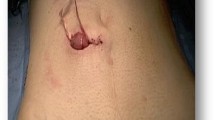Abstract
Background: The management of rectal cancer has been changing to include more sphincter-sparing procedures. We report our initial experience with a new technique incorporating laparoscopy and a transsacral approach for low or midlevel rectal cancer. Here, we tried to determine whether this sphincter-sparing method could produce acceptable morbidity and recurrence rates.
Methods: Patients with rectal cancer 4 to 8 cm from the dentate line underwent laparoscopically-assisted transsacral resection (LTR) with primary anastomosis. With this technique, the rectosigmoid is mobilized via laparoscopy while the patient is in the supine position. Next, the patient is placed in the prone jackknife position, and a segment of rectum is resected by a transsacral approach. Age, estimated blood loss, length of time in the operating room, length of stay, and postoperative complications were noted. Aspects of the tumor pathology regarding stage, lymph nodes, tumor size, and presence of tumor at resection margins also were recorded.
Results: A total of 13 patients, ages 26 to 70 years (mean, 52.5 years), underwent the procedure. No perioperative deaths occurred. The mean hospital stay was 9.6 days. The average size of the rectal lesion was 4.3 cm in the largest dimension. The average specimen contained 11.5 total, and 2.0 metastatic lymph nodes. Postoperative complications included two anastomotic breakdowns and two other wound complications. Late follow-up evaluation ranged from 10 to 30 months, with 11 of 13 patients alive (85% survival). Two local recurrences and three distant recurrences were noted at long-term follow-up assessment.
Conclusions: In selected patients with low or midlevel rectal cancer, LTR may be a viable option. Further experience is necessary to define its oncologic efficacy and whether routine temporary diverting colostomy is indicated.
Similar content being viewed by others
References
Adloff M, Oilier JC, Arnaud JM (1983) L’abord posterior du rectum: techniques, indications, complications: a propos de 41 observations J Chir 120: 205–210
Arnaud A, Fretes IR, Joly A, Sarles JC (1991) Posterior approach to the rectum for the treatment of selected benign lesions Int J Colorectal Dis 6: 100–102
Balslev IB, Peterson M, Teglbjaerg P (1986) Postoperative radiotherapy in Dukes B and C carcinoma of the rectum and rectosigmoid Cancer 58: 22–28
Bleday R, Breen E, Jessup JM, Burgess A, Sentovich SM, Steele G Jr (1997) Prospective evaluation of local excision for small rectal cancers Dis Colon Rectum 40: 388–392
Breen E, Bleday R (1997) Preservation of the anus in the therapy of distal rectal cancers Surg Clin North Am 77: 71–83
Fielding GA, Lumley J, Nathanson L, Hewitt P, Rhodes M, Stite R (1997) Laparoscopic colectomy Laparoscopic colectomy Surg Endosc 11: 745–749 DOI: 10.1007/s004649900441
Goligher JC, Dukes CE, Bussey HJR (1951) Local recurrences after sphincter-saving excisions for carcinoma of the rectum and rectosigmoid Br J Surg 39: 199
Hugier M, Chastang C, Houry S, Martin-Fernandez M, Milsom JW, Church JM (1997) Sphincter-sparing resection or not, for cancer of the midrectum. Am J Surg 174: 11–15
Huscher CSG, Lirici MM, Angelini L (1997) Laparoscopic colectomy. Surg Endosc 11: 875–876 DOI: 10.1007/s004649900475
Jessup JM, Bleday R, Busse P (1993) Conservative management of rectal carcinoma: the efficacy of a multimodality approach. Semin Surg Oncol 9: 39–45
Kirkegaard P, Madsen PV (1982) Ugeskrift for Laeger. 144: 3832–3834
Kraske P (1985) Zur extirpation hochsitzender mastdarmkrebse. Ver dt Ges Chir 14: 464
Lavery IC, Lopez-Kostner F, Fazio VW (1997) Chances of cure are not compromised with sphincter-saving procedures for cancer of the lower third of the rectum. Surgery 122: 779–785
Localio SA, Stahl NM (1969) Simultaneous abdominotranssacral resection and anastomoses for midrectal cancer. Am J Surg 117: 282–289
Mason AY (1974) Trans-sphincteric surgery of the rectum. Prog Surg 13: 66–97
Miles WE (1908) A method of performing abdominoperineal excision for carcinoma of the rectum and of the terminal portion of the pelvic colon. Lancet 2: 1812–1813
Minsky BD, Coia L, Haller DG (1998) Radiation therapy for rectosigmoid and rectal cancer: results of the 1992–1994 Patterns of Care process survey. J Clin Oncol 16: 2542–2547
Molenaar CBH, Bijnen AB, de Ruiter P (1998) Indications for laparoscopic colorectal surgery. Surg Endosc 12: 42–45 DOI: 10.1007/S004649900589
Murray JJ, Stahl TM (1993) Sphincter-saving alternatives for treatment of adenocarcinoma involving distal rectum. Surg Clin North Am 73: 131–144
Ng AK, Recht A, Busse PM (1997) Sphincter preservation therapy for distal rectal carcinoma: a review. Cancer 79: 671–683
Parks AG, Percy JP (1982) Resection and sutured coloanal anastomosis for rectal carcinoma. Br J Surg 69: 301–304
Senagore AJ (1994) Intrarectal and intraanal ultrasonography in the evaluation of colorectal pathology. Surg Clin North Am 74: 1465–1472
Steele G, Busse P (1993) Conservative management of rectal carcinoma: the efficacy of a multimodality approach. Semin Surg Oncol 9: 39–45
Wexner SD, Cohen SM (1995) Port-site metastasis after laparoscopic colorectal surgery for cure of malignancy. Br J Surg 82: 295–298
Wolmark N, Fisher B (1993) An analysis of survival and treatment failure following abdominoperineal and sphincter-saving resection in Dukes B and C rectal carcinoma: a report of the NSABP clinical trials. Ann Surg 204: 480–489
Yeatman T, Bland K (1989) Sphincter-saving procedures for distal carcinoma of the rectum. Ann Surg 209: 1–17
Author information
Authors and Affiliations
Additional information
Online publication: 12 July 2000
Work performed entirely at Wayne State University
Rights and permissions
About this article
Cite this article
Weaver, D.W., Eachempati, S.R. Laparoscopically assisted transsacral resection of rectal cancer with primary anastomosis. Surg Endosc 14, 703–707 (2000). https://doi.org/10.1007/s004640020085
Received:
Accepted:
Issue Date:
DOI: https://doi.org/10.1007/s004640020085




